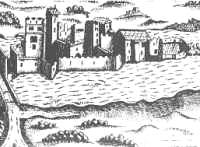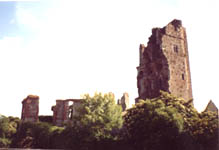
Askeaton Castle in the 16th century
Pacata Hibernia, 1633

Askeaton Castle in ruins today
Eleanor Fitzgerald (born 1495), daughter of Gearóid Mór, 8th Earl of Kildare, was a woman who placed the interests of her own family before that of her husband's. Disaster struck the house of Kildare when her brother Gearóid Óg, 9th Earl of Kildare died in 1534 and her five brothers and nephew, Silken Thomas were all executed in London in 1536.
However, a young male heir named Gerald survived and Eleanor, now the widow of Donal McCarthy Reagh of Cork agreed to marry Manus O'Donnell of Tír Conaill whom she disliked, in order to protect this important nephew. She brought him under guard all the way from Cork to Donegal, married Manus and subsequently arranged to have Gerald sent to the Continent for safety. She left Manus after a year when she suspected him of disloyalty to the boy and returned to her own family.
It is also interesting to note that this same Eleanor, daughter of the extremely powerful Gearóid Mór, 8th Earl of Kildare, was twice married into Gaelic families. Her father had made astute political use of the marriages of his daughters into both Gaelic and Anglo-Irish families.
Eleanor Butler, Countess of Desmond (c.1545 - c.1638), was born into a branch of the Ormond Butlers, a family less Gaelicised than most other Old English families and generally loyal to the English crown at this period. Yet both Eleanor's mother and Butler grandmother were McCarthys from Cork and of Gaelic stock.
At age nineteen, Eleanor married Gerald Fitzgerald, 15th Earl of Desmond and entered on an eventful and tragic career as the terrible Munster Rebellions coincided with the prime of her life and child-bearing years.
Like his ancestors, the Earl of Desmond practised a combination of Gaelic and Anglo Norman leadership. He was immensely rich and powerful claiming overlordship of about half a million acres in Munster and of several Gaelic sub-chiefs as well as ownership of the port towns of Youghal and Kinsale. Eleanor and Gerald had several castles and lived mainly at Askeaton Castle, Co. Limerick with servants, a magnificent hall, orchards, gardens and fishponds.
|
Askeaton Castle in the 16th century |
Askeaton Castle in ruins today |
The Earl of Desmond was determined to resist the encroachment of English control over his territories while Elizabeth I was equally determined to overcome his resistance. His style of rule kept most of his Gaelic subjects loyal. However, it involved occasional raids on his enemies and to the English this behaviour was treasonable defiance of their centralising authority. They determined to subdue the Earl of Desmond.
Whenever he languished in custody or in prison Eleanor managed his subjects and estates with a combination of ruthlessness and diplomacy. When Gerald was committed to the Tower of London, she went to live with him there and coaxed her way into the presence of Queen Elizabeth I to beg for pardon. During very troubled years she gave birth to five daughters and a son, all of whom were placed in fosterage.
Eleanor pleaded, submitted, bargained and acted as go-between with Gerald's enemies, subjects and friends, whether Irish or English. She had influential connections and great powers of persuasion - both of which she used to plead for pardon from the queen and her officers. She reported to the English authorities how she advised Gerald to surrender to them and conform to English customs. She gave her son to English officials to present to Queen Elizabeth, partly to preserve his life from both English and Irish enemies and partly as an indication of the loyalty of herself and her husband. She may have believed that the Gaelic way of life was doomed or she may have been playing a diplomatic game, biding her time. Yet she remained stubbornly loyal to Gerald as he tried to hold on to his estates and authority in Desmond.
When Gerald himself led the second Desmond Rebellion, Eleanor accompanied him on the run in Limerick and Kerry, living a hunted life in cabins, caves and woods in constant danger of betrayal while their magnificent castle at Askeaton was blown up and their vast Munster lands devastated.
Her husband's brother was arrested, executed and his head stuck on a spike in Cork for three years. Eventually her husband was killed, beheaded and his head sent as a trophy to Queen Elizabeth. The Desmond territories in Munster were confiscated and portioned out to English adventurers during the Munster Plantation.
Undaunted, Eleanor was back in London trying to rescue her fortunes and those of her family. There she met Donogh O'Connor Sligo, married him and began another career of intrigue, bargaining, mediating and negotiating. Her daughters married but her son Gerald, the 16th Earl of Desmond died in mysterious circumstances in London, having spent most of his young life as a hostage or a pawn in one kind of captivity or another. Eleanor lived to be over ninety years of age.
Elizabeth Butler (1615-1684), née Preston, Countess and later Duchess of Ormond and a Butler heiress, married her cousin James Butler who became Duke of Ormond on the Restoration of Charles II. Though her husband was loyal to the Royal cause during the Commonwealth, Elizabeth took a very practical approach to politics, her main concern being to protect the family property and the inheritance of her children. She took legal action, petitioned people in high places, including Cromwell, made use of personal contacts and lived apart from her husband during the Commonwealth.
|
Your Lordship may please to understand that there descended to me an estate by inheritance in Ireland, which together with the rest of my Lord's fortune, is now by war and pestilence very much depopulated ... by Your Lordship's permission and furtherance, I would propose to raise a subsistence for myself and children, if by Your Lordship I should be encouraged to endeavour it, and directed how most advantageously to apply myself to it. |
Her surviving correspondence also shows how she advised and warned her husband, worried about her sons and used her considerable influence in court in later life as Duchess of Ormond.